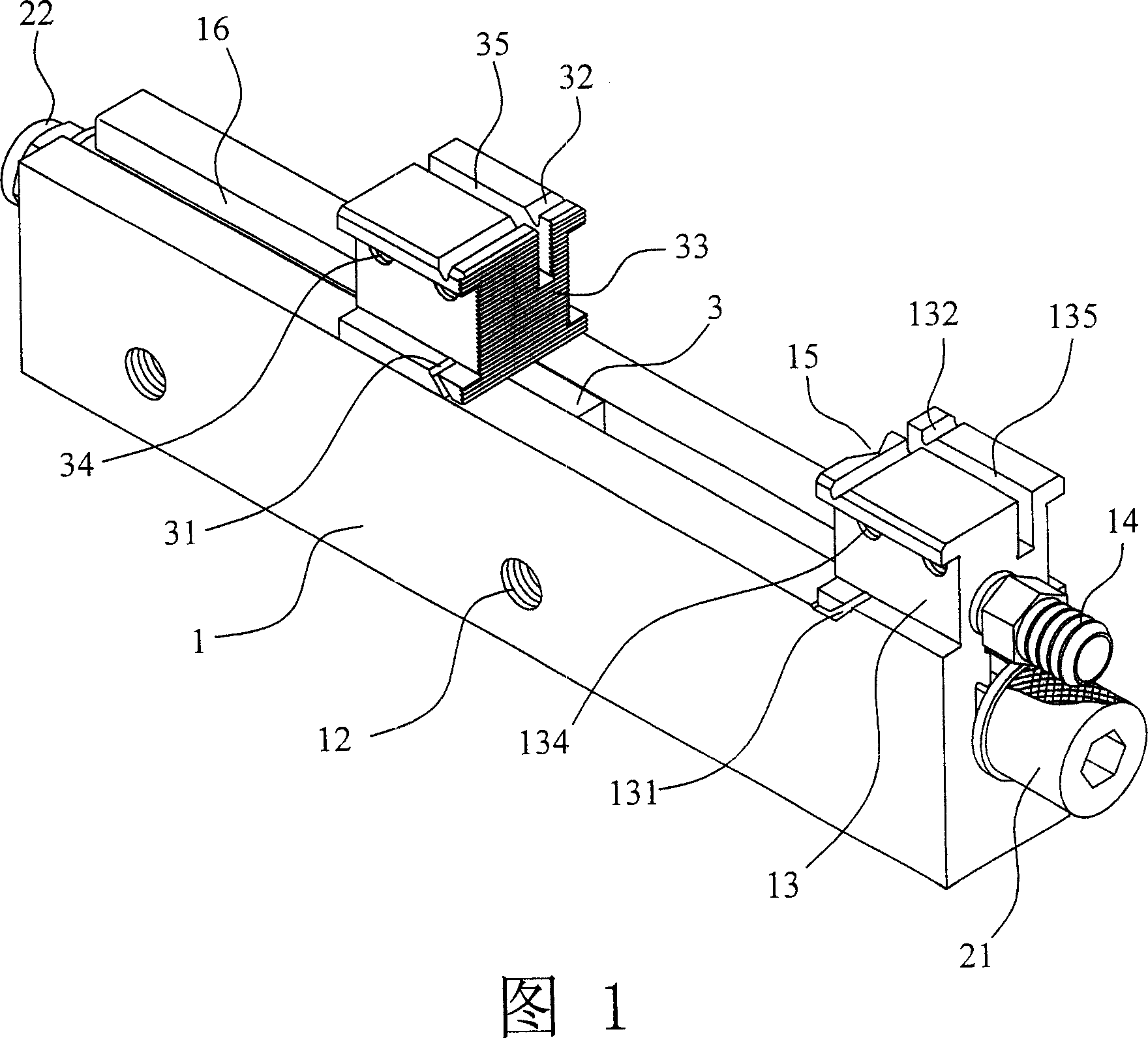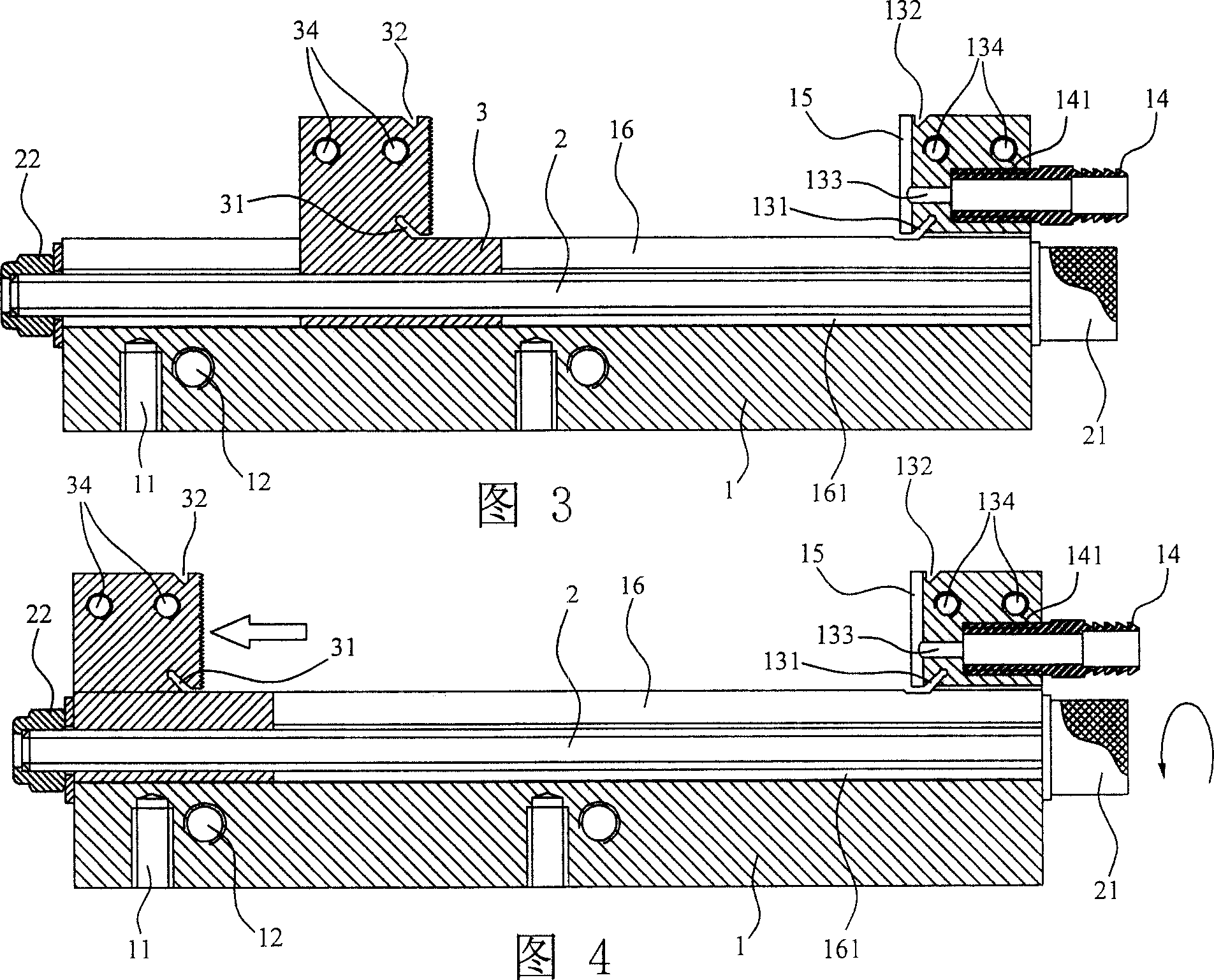[0002] In the manufacturing and
processing process of plastic injection molds, forming electric
discharge is recognized as the most time-consuming and frequently used processing process in the industry. The so-called electric
discharge machining is the continuous repeated contact and separation of an electrode and the mold to be processed by sliding back and forth. And other actions, with the passage of current, the electrode and the mold will be melted at high temperature and gasified immediately. Since the material of the general electrode is
copper, its
conductivity is better than the iron material of the general plastic injection mold, so the loss of the mold will be more. The required shape and size are molded with the help of molds; however, at present, for the electrode clamping and fixing of electric
discharge machining, although there are electrode fixtures specially designed for fixed brand electric discharge machining tools, the entire
system must be imported from abroad when
purchasing. At present, the manufacturing of plastic injection molds in Taiwan is mostly outsourced processing, and the overall
system is expensive, resulting in a low
penetration rate in the industry
[0003] Based on the above reasons, most mold makers can only rely on traditional quick-
drying, tapping lock screws, vises or
drill clamps to fix electrodes during EDM, but these methods can only be used for specific electrode shapes And use, and it all has serious shortcoming, causes in the flow process of discharge operation, just spends on fixing the electrode and is quite troublesome, and its
instability is more likely to cause damage to the important parts of mold, for the above-mentioned various traditional The electrode fixing method is described as follows:
[0004] 1. The fixing method of the traditional
vise to clamp the electrode: since the clamping
stroke of the traditional
vise and its
width ratio is about 3:2, that is, if the electrode with a width of 135mm is to be clamped, the width of the traditional
vise will be about 100mm , In this way, not only is it bulky and the width is too large, but the electrode with a small size will have many restrictions on the use, for example: when the electrode and the mold are centered or when the
height difference between the mold surface is large, it can pass through It can be overcome by increasing the length of the electrode or replacing the vise with a smaller size, but generally EDMs only do OEM work for customers, and the molds and electrodes are provided by customers, and customers generally do not consider this issue for processors. Moreover, the lengthening of the electrode size will also increase its production cost (both material costs and wages increase). If replacing the vise is considered, it means that the processor must prepare a variety of vise specifications just to clamp the rectangular electrode, not to mention the rectangular vise. There are often no right angles or parallel parts on the periphery of the electrode that can be clamped, and the surface is rough (such as the electrode made by a
CNC milling machine). Therefore, the clamping effect of the traditional vise is not good. In the middle, the electrode will move and fall off due to the unclamping, which will cause irreparable damage to the mold!
[0005] In addition, during the discharge
machining process, the contact surface between the electrode and the mold must be continuously washed by the discharge
machining fluid in order to remove the oxides generated during the discharge. On the contact surface between the mold and the electrode, rapid accumulation occurs, resulting in
carbon deposition, especially for circular electrodes (usually used to make injection holes, which are characterized by small and deep, very easy to "
carbon deposition"), If it is clamped with a traditional vise, it must use the oil
pipe equipped with the electric discharge
machine to align the contact surface between the electrode and the mold and spray oil to flush it. The cleaning effect of this method is limited, and carbon deposits or
chip removal (oxidation Things) poor effect and result in poor processing
[0006] There is also a strip-shaped electrode called a
thin sheet (Rib). Generally, there are fixed specifications available for purchase, and then the shape of the other direction can be made according to the design of the mold; if the length of the electrode after processing is greater than 80mm, Then it will be very easy to curl. If the length is more than 200mm (or even 300mm), you must use a large vise to clamp it, so that there is enough clamping surface to clamp the electrode straight, but usually the vise used for discharge is not no such big specs
[0007] 2. Tapping lock screw fixing:
Drill and tap the opposite surface of the finished electrode surface (contact surface with the mold), and fix it on a special conductive rod with screws. As mentioned earlier, the general electrode is made by the customer. provided, but the customer who provided the electrode may not have considered the tapping operation, and the processor has no other suitable fixing method, so they can only supplement the drilling on the back of the electrode. In this way, not only will the electrode be damaged The risk of finished products is more likely to cause schedule delays
[0008] In addition, due to the soaring international
copper price, drilling holes will cause the electrode to be unable to be turned over for reuse, resulting in virtually waste; and when the size of the electrode is larger than the size of a pack of cigarettes, two screw holes may be required to fix it , and if the distance between the two screw holes does not match the tool owned by the processor, another problem will be formed
[0009] 3. Quick-
drying (quick
adhesive) fixation: In practical processing, small-sized electrodes are often glued to the conductive round rod by quick-
drying, that is, the conductive round rod can be fixed on the head of the discharge
machine to discharge
Processing, but the premise is that the electrode should not be too heavy, otherwise it may not stick. Once the electrode falls during processing, it may be damaged (because copper is softer than iron). (The instantaneous temperature of discharge sometimes exceeds the range that can be tolerated by quick-drying) may deteriorate, causing the electrodes to fall off
In addition, when using quick-drying to adhere the electrode and the conductive round rod, sometimes the electrode and the conductive round rod will be poorly conductive, or even insulated so that the discharge cannot be performed; After the electrode is separated from the conductive rod, some quick-drying stains will remain on the surface of the electrode. If the same electrode needs to be used again next time, it will take a lot of time to remove the old quick-drying stains without damaging the electrode. Flip hands and feet, quite troublesome
 Login to View More
Login to View More  Login to View More
Login to View More 


